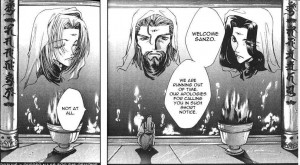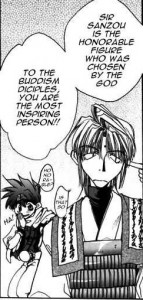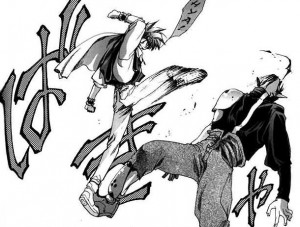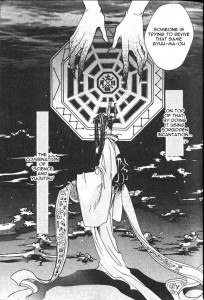Saiyuki (vol. 1)
By Kazuya Minekura
In my last manga-related post, I received more than a few reading recommendations in the comments. I plan to give them all a try (eventually), but for this week I took Vom Marlowe’s advice and read the first volume of Saiyuki.
For those of you unfamiliar with the title, Saiyuki is a *very* loose adaptation of the classic Chinese novel, Journey to the West. Rather than a monk traveling West to obtain authentic sutras, Saiyuki depicts the adventures of a monk tasked with preventing the revival of a demon lord, Gyumaoh. As in the novel, the monk is accompanied by three companions, including the Monkey King, Son Goku. Also, the monk is given a dragon that serves as his mount. But instead of transforming into a horse, as it does in the novel, the dragon in Saiyuki transforms into a Jeep (it’s a joke that worked for me precisely because it’s so random).
The story is set in the mountainous fantasy realm of Tougenkyou, (which I presume is like Shangri-la). In Tougenkyo, humans lived peacefully alongside a race of demons called Youkai, but the recent efforts to revive Gyumaoh have caused most of the Youkai to go feral. The monk, Genjyo Sanzo, and his three companions are Youkai as well, but their powers are controlled so they can serve the interests of humanity. The conflict with the Youkai serves as a convenient excuse to include plenty of action, which often takes up the lion’s share of each chapter.
While the plot is simple, I was often confused as to exactly what was going on. Some of this is due to my own ignorance of Eastern myth. For example, when I first read the volume I didn’t understand why Sanzo was taking orders from three giant heads.
After doing a little research I learned that they were the Sanbutsushin, the three aspects of Buddha. There were numerous references to Buddhist mythology (even during the fight scenes), most of which probably went right over my head.
A good deal of my confusion was also due to the amateur translation. I read Saiyuki using Mangafox.com, because I am cheap. But you get what you pay for, because a manga that’s translated for free by fans tends to have numerous spelling errors and grammatical mistakes. While I can’t say for sure, I also suspect that the translation didn’t capture the nuances of the original Japanese prose. Quite of few lines of dialogue felt stilted, and some even bordered on nonsensical.
In the above panel, I can make out the gist of what’s being said, but those lines are pretty damn terrible (and did I mention the spelling mistakes?). Of course, that might be how the manga actually reads in Japanese, but I’m going to give Kazuya Minekura the benefit of the doubt.
Setting my confusion aside, initially I was not very impressed with Saiyuki. The quality of the art (which I discuss below) was uneven. The main characters lacked depth, even by the end of the volume. Now, I understand that this is a shonen manga, heavy on action, light on characterization. But everyone was just so damn archetypal: Sanzo is the stoic leader, Cho Hakkai is the nice guy, Sha Gojyo is the womanizer, and Son Goku is the bratty kid.
About halfway into the volume, however, my opinion started to change. It wasn’t that the characters became substantially more interesting, but that Minekura provided just enough hints that there was more to the story and characters than was immediately evident. There were a few scenes that suggested that the Sanbutsushin are not the flawless embodiment of good, nor are the villains purely evil. There were also brief moments that promised deeper characterization for the heroes. Son Goku, for example, was noticeably hurt when a human girl expressed hatred for the Youkai. Also, the last chapter highlighted that Sanzo is indifferent to the teachings of Buddha, despite the fact that he’s technically a high-ranking monk. I’m not ecstatic about her writing, but Minekura has piqued my curiosity, and that’s enough to get me to try out the next volume (though I’ll probably look for a version that’s been translated by a professional).
The art is hit and miss. Saiyuki adheres to a style that seems (to my admittedly inexperienced eyes) to be the mainstream of manga and anime: big eyes, angular features, spiky hair, lots of speed lines during fights. I don’t find this style repulsive by any means, but it’s never really appealed to me either. It’s more like something I tolerate if I happen to enjoy a story. Even if I was more appreciative of the basic style, there are a few problems with Minekura’s storytelling. Panel layout during the fight sequences can be bewildering, and spatial relationships are not easy to figure out. And big splashy images are sometimes used at the expense of narrative clarity. On the plus side, Minekura doesn’t hold back on the violence, and she knows how to draw a kick that looks like it hurts.
The best moments in Saiyuki are when the book deviates from the typical manga look and instead draws inspiration from traditional Chinese and Japanese artwork. The art becomes much more distinctive, and I get the sense that Minekura is more enthusiastic about these infrequent pages than she is about the lengthier fight scenes.
I particularly like the ethereal quality of the kimono, and the way the hands blacken as they touch the … whatever the hell that is (unless corrected, I’ll call it the evil, octagonal web thing).
To sum up, Saiyuki is a deeply flawed title with the potential to become much better in subsequent volumes. Hopefully, the next volume will read less like a generic shonen story and more like an idiosyncratic blend of Buddhist mythology and road-trip adventure.




